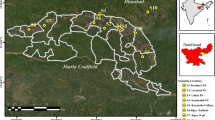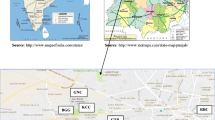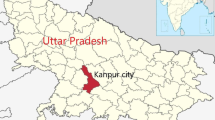Abstract
A plant is a living machine which reduces air pollution by absorbing particulate matter, gases, and metals through leaves. The main polluting substances, i.e., sulfur oxides, nitrogen oxides, and heavy metals, cause damage to the surrounding ecosystem. In the present study, the air pollution tolerance index values of 36 plant species have been evaluated by analyzing three important biochemical parameters and one physiological parameter. The other biological and socioeconomic parameters of these plant species were also considered along with air pollution tolerance index values for calculating anticipated performance index under the influence of overall pollution stress. Based on these two indices, the most pollution-tolerant and economically valuable plant species have been identified for green belt development in and around an urban industrial area, Durgapur, West Bengal, India. It was revealed that Lagerstroemia speciosa (Jarul), Schleichera oleosa (Kusum), and Thespesia populnea (Pipal) would be the outstanding performers. There are many types of assessment categories which were estimated with respect to air pollution tolerance index and anticipated performance index.



Similar content being viewed by others
References
Agbaire PO, Akporhonor EE (2014) The effects of air pollution on plants around the vicinity of the Delta Steel Company, Ovwian-Aladja, Delta State, Nigeria. IOSR J Environ Sci Toxicol Food Technol (IOSR-JESTFT) 8:61–65
Agrawal M, Deepak SS (2003) Physiological and biochemical responses of two cultivars of wheat to elevated levels of CO2 and SO2, singly and in combination. Environ Pollut 121:189–197
Arnon DI (1949) Copper enzymes in isolated chloroplasts polyphenol oxidase in Beta Vulgaris. Plant Physiol 2(1):1–15
Bakiyaraj R, Ayyappan D (2014) Air pollution tolerance index of some terrestrial plants around an industrial area. Int J Mod Res Rev 2:1–7
Banerjee S, Palit D, Banerjee A (2016) Changing strategies of biochemical & physiological features of selected plant species on effect of air pollution in Eastern Steel City, Durgapur, India. Int J Curr Microbiol Appl Sci 5(9):733–741
Beckett KP, Freer-Smith PH, Taylor G (1998) Urban woodlands: their role in reducing the effects of particulate pollution. Environ Pollut 99:347–360
Bhattacharya T, Kriplani L, Chakraborty S (2013) Seasonal variation in air pollution tolerance index of various plant species of Baroda City. Univers J Environ Res Technol 3(2):199–208
Blokhina O, Virolinen E, Fagerstedt KV (2003) Antioxidants, oxidative damage and oxygen deprivation stress: a review. Ann Bot 91:179–194. https://doi.org/10.1093/aob/mcf118
Bora M, Joshi M (2014) A study on variation in biochemical aspects of different tree species with tolerance and performance index. Ecoscan 9(1):59–63
Brack CL (2002) Pollution mitigation and carbon sequestration by an urban forest. Environ Pollut 117 (S1):S195–S200
Chaudhary CS, Rao DN (1977) A study of some factors in plants controlling their susceptibility to sulphur dioxide pollution. Proc Indian Natl Sci Acad 46:236–241
Chaves MM, Maroco JP, Pereira JS (2003) Understanding plant responses to drought—from genes to the whole plant. Funct Plant Biol 30:239–264
Cunningham WP, Cooper TH, Gorhani E, Hepworth MT (2001) Environmental encyclopedia, 2nd edn. Jaico Publ. House, Mumbai, p 1196p
Das S, Prasad P (2010) Seasonal variation in air pollution tolerance indices and selection of plant species for industrial areas of Rourkela. Indian J Environ Prot 30(12):978–988
Dedio W (1975) Water relations in wheat leaves as screening tests for drought resistance. Can J Plant Sci 55:369–378
Enete IC, Chukwudeluzu VU, Okolie AO (2013) Evaluation of air pollution tolerance index of plants and ornamental shrubs in Enugu City: implications for urban heat island effect. World Environ 3(3):108–115
Escobedo FJ, Wagner JE, Nowak DJ (2008) Analyzing the cost effectiveness of Santiago, Chile’s policy of using urban forests to improve air quality. J Environ Manag 86:148–157
Foyer CH, Lelandais MA (1996) A comparison of the relative rates of transport of ascorbate and glucose across the thylakoid, chloroplast and plasmalemma membranes of pea leaves mesophyll cells. J Plant Physiol 148:391–398
Garg A, Saxena P, Ghosh C (2015) Evaluation of tolerance and sensitivity of selected plant species with special reference to gasoline exhaust pollution. Int J Sci Technol Res 4(2):199–207
Geravandia M, Farshadfara E, Kahrizi D (2011) Evaluation of some physiological traits as indicators of drought tolerance in bread wheat genotypes. Russ J Plant Physiol 58(1):69–75
Gupta R, Chaudhari B, Wate SR (2008) Overview on attenuation of industrial air pollution by greenbelt. J Ind Pollut Control 24:1–8
Gupta S, Nayek S, Bhattacharya P (2011) Effect of air-borne heavy metals on the biochemical signature of tree species in an industrial region, with an emphasis on anticipated performance index. J Chem Ecol 27(4):381–392
Jyothi SJ, Jaya DS (2010) Evaluation of air pollution tolerance index of selected plant species along roadsides in Thiruvananthapuram, Kerala. J Environ Biol 31:379–386
Katiyar V, Dubey PS (2001) Sulphur dioxide sensitivity on two stage of leaf development in a few tropical tree species. Indian J Environ Toxicol 11:78–81
Kuddus M, Kumari R, Ramteke WP (2011) Studies on air pollution tolerance of selected plants in Allahabad city, India. J Environ Manag 2(3):42–46
Mashita PM, Pise VL (2001) Biomonitoring of air pollution by correlating the pollution tolerance of some commonly grown trees of an urban area. Pollut Res 20(2):195–197
Liu YJ, Ding H (2007) Variation in air pollution tolerance index of plants near a steel factory: implication for landscape-plant species selection for industrial areas. WSEAS Trans Environ Dev 4:24–32
Mukherjee SD, Chaudhuri MA (1983) Implications of water stress induced changes in the levels of endogenous ascorbic acid and hydrogen peroxide in Vigna seedlings. Physiol Plant 58:166–170
Ninave SY, Chaudhri PR, Gajghate DG, Tarar JL (2001) Foliar biochemical features of plants as indicators of air pollution. Bull Environ Contam Toxicol 67:133–140. https://doi.org/10.1007/s00128-001-0101-3
Pandey AK, Pandey M, Tripathi BD (2015) Air pollution tolerance index of climber plant species to develop vertical greenery systems in a polluted tropical city. Landsc Urban Plan 144:119–127. https://doi.org/10.1016/j.landurbplan.2015.08.014
Prajapati SK, Tripathi BD (2008) Anticipated performance index of some tree species considered for green belt development in and around an urban area: a case study of Varanasi city, India. J Environ Manag 88:1343–1349. https://doi.org/10.1016/j.jenvman.2007.07.002
Rahmawati N, Rosmayati D, Basyuni M (2014) Chlorophyll content of soybean as affected by foliar application of ascorbic acid and inoculation of arbuscular mycorrhizal fungi in saline soil. Int J Sci Technol Res 3(7):127–131
Rai P, Panda LS (2014) Dust capturing potential and air pollution tolerance index (APTI) of some road side tree vegetation in Aizawl, Mizoram, India: an Indo-Burma hot spot region air quality. Air Qual Atmos Health 7(1):93–101. https://doi.org/10.1007/s11869-013-0217-8
Rai R, Rajput M, Agrawal M, Agrawal SB (2011) Gaseous air pollutants: a review on current and future trends of emissions and impact on agriculture. J Sci Res 55:77–102
Rawat JS, Banerjee SP (1996) Urban forestry for improvement of environment. J Energy Environ Monit 12(2):109–116
Sanghi SB, Sharma C, Sanghi SK (2015) Comparison of APTI values of some medicinal plants of industrial areas and Ratapani wild life sanctuary in Raisen district of Madhya Pradesh. Int J Pharm Life Sci 6(1):4157–4160
Sen DN, Bhandari MC (1978) Ecological and water relation to two Citrullus spp. In: Althawadi AM (ed) Indian arid zone. Environmental physiology and ecology of plants, pp 203–228
Shannigrahi AS, Fukushima T, Sharma RC (2004) Anticipated air pollution tolerance of some plant species considered for green belt development in and around an industrial/urban area in India: an overview. Int J Environ Stud 61(2):125–137. https://doi.org/10.1080/0020723032000163137
Shannigrahi AS, Sharma RC, Fukushima T (2003) Air pollution control by optimal green belt development for Victoria Memorial Monument, Kolkata (India). Int J Environ Stud 60(3):241–249
Sharma SC, Sharga AN, Roy RK (1994) Abatement of industrial pollution by landscaping. Indian J Environ Prot 14(2):95–97
Singh A, Agrawal M (2008) Acid rain and its ecological consequences. J Environ Biol 29(1):15–24
Singh SK, Rao DN (1983) Evaluation of plants for their tolerance to air pollution. In: Proceedings of the symposium on air pollution control, November 83, pp 218–224
Smirnoff N (2000) Ascorbic acid: metabolism and functions of a multifaceted molecule. Curr Opin Plant Biol 3:229–235
Thakar BK, Mishra PC (2010) Dust collection potential and air pollution tolerance index of tree vegetation around Vedanta Aluminium Limited, Jharsuguda. Bioscan 3:603–612
Tiwari S, Bansal S, Rai S (1993) Expected performance indices of some planted trees of Bhopal. Indian J Environ Health 35(4):282–286
Tripathi AK, Gautam M (2007) Biochemical parameters of plants as indicators of air pollution. J Environ Biol 28:127–132
Acknowledgements
The authors are grateful to Prof. Ambarish Mukherjee, Dept. of Botany, University of Burdwan for identification of plant species. Authors are also thankful to the Assistant Professor R. Chatterjee, Dept. of English, Sanskrit College University, Kolkata, and professors of Conservation Biology, Durgapur, West Bengal, India, to carry forward the research work. This research did not receive any specific grant from funding agencies in the public, commercial, or not-for-profit sectors.
Author information
Authors and Affiliations
Corresponding author
Additional information
Editorial responsibility: M. Abbaspour.
Rights and permissions
About this article
Cite this article
Banerjee, S., Banerjee, A., Palit, D. et al. Assessment of vegetation under air pollution stress in urban industrial area for greenbelt development. Int. J. Environ. Sci. Technol. 16, 5857–5870 (2019). https://doi.org/10.1007/s13762-018-1963-9
Received:
Revised:
Accepted:
Published:
Issue Date:
DOI: https://doi.org/10.1007/s13762-018-1963-9




